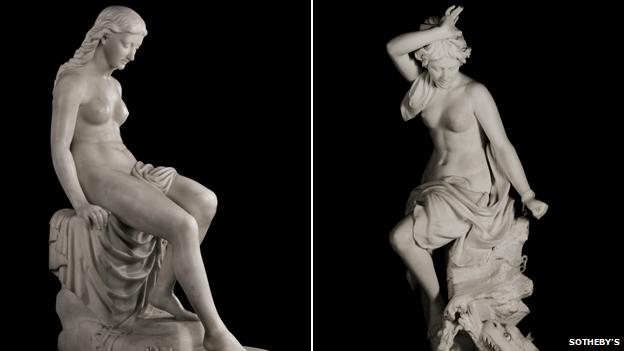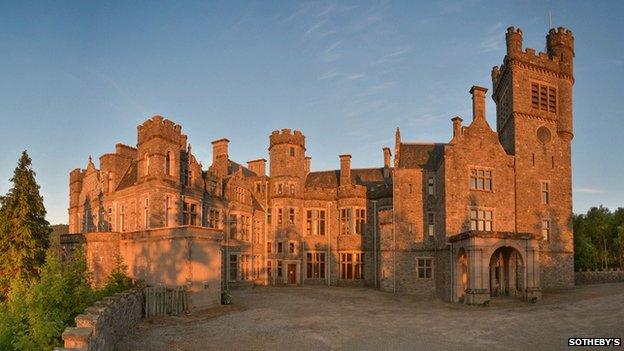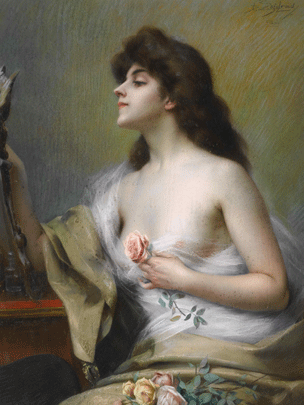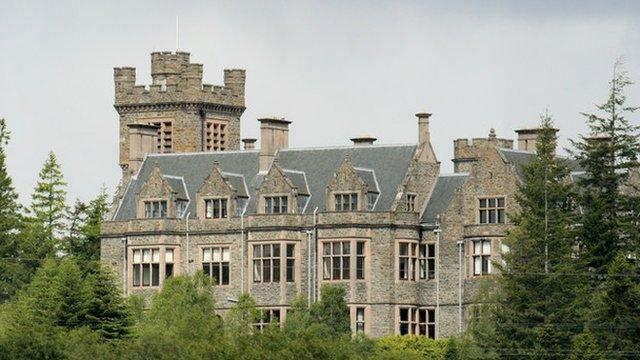Artworks at Sutherland's Carbisdale Castle to be sold
- Published

The sculptures have been put on the market for the first time in more than 100 years
Valuable artworks held in what was one of Scotland's most spectacular youth hostels are to be sold at auction.
The Scottish Youth Hostels Association (SYHA) shut Carbisdale Castle in Sutherland four years ago because of rising repair costs.
A former stately home, it was known as Castle of Spite because of the part it played in a family feud. The property is also said to be haunted.
Auctioneers Sotheby's have put a combined value of £500,000 on the art.
The 17 sculptures and 36 Italian and Scottish 19th Century paintings will be offered for sale at an auction in London on 20 May.
White marble sculptures from the 1800s to be sold include Andromeda by Florentine sculptor Pasquale Romanelli and Nymph at the Stream by Scottish artist David Watson Stevenson.
It will be the first time in more than a century that the Victorian sculptures have been put on the market.

Carbisdale Castle overlooks the Kyle of Sutherland in the Highlands
SYHA is also understood to be close to completing the sale of Carbisdale Castle.
In October last year, the association said the selling agents had received notes of interest and these were being considered.
Keith Legge, of SYHA, said: "It has been a privilege for SYHA to have been the custodian of Carbisdale Castle and its contents for the past 70 years enabling our members and guests to experience living in a castle.
"SYHA as a self-funding registered charity has a responsibility to manage appropriately its assets for the good of the organisation.

The sale of the art will raise funds for the youth association
"The proceeds of the sale will be used to sustain SYHA's diverse youth hostel network of affordable fit-for-purpose accommodation, allowing everyone, but especially young people, to learn and experience what Scotland has to offer."
The castle, which overlooks the Kyle of Sutherland, was shut as a hostel after suffering frost damage.
Historic Scotland lists the castle and its entrance gates as category B, which means they are structures of regional importance.
The Dowager Duchess of Sutherland had Carbisdale Castle built between 1907 and 1917 following the death of her husband, George Granville William Sutherland-Leveson-Gower, the Third Duke of Sutherland.
Lady Mary was the duke's second wife and after he died she became embroiled in a legal dispute over his will with her stepson, the fourth Duke of Sutherland.
When the row was settled the duchess used her inheritance to have Carbisdale constructed.
Female ghost
According to geographical encyclopaedia, The Gazetteer of Scotland, the property became known as the Castle of Spite.
Its clock tower only has three faces with none that could be seen by the new duke as he passed by in his private train on his way to Dunrobin Castle, near Golspie, his family's property in Sutherland.
It is also said that he would have the blinds of his carriage shut so he did not have to look at Carbisdale.
The castle was bought by a Scots-Norwegian family in 1933 and was used as a refuge for the Norwegian royal family during World War II.
The gazetteer adds that the castle is haunted by a female ghost called Betty.
- Published3 October 2014

- Published25 March 2013
